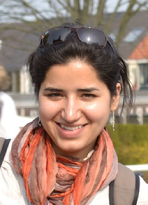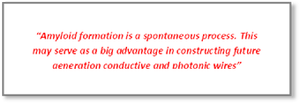 In this thesis fibrillization characteristics of α-synuclein are studied. The αSynuclein fibrils can serve as scaffolds for creating hybrid bionanostructures. ‘Fibrillization of αSyn can be carefully modulated by solution conditions,’ Arshdeep Sidhu says. ‘The ability to produce morphologically homogeneous fibrils turns them into an attractive biomaterial, for use in the fabrication of nanophotonic and nanoelectronic devices.’ The fibrils are small in diameter (approximately 7 nm) and their mechanical strength supersedes that of steel. ‘The spontaneous self-assembling properties are a big advantage,’ Arshdeep adds to that. ‘We worked on additional control to form uniform fibrils. Also gold nanoparticles were put onto the fibrils.’ The real challenge is to make the wires conductive. A new method was provided to measure and characterize these wires using interconnected electrodes, rather than performing FEM conductive measurement, which are limited in accuracy.
In this thesis fibrillization characteristics of α-synuclein are studied. The αSynuclein fibrils can serve as scaffolds for creating hybrid bionanostructures. ‘Fibrillization of αSyn can be carefully modulated by solution conditions,’ Arshdeep Sidhu says. ‘The ability to produce morphologically homogeneous fibrils turns them into an attractive biomaterial, for use in the fabrication of nanophotonic and nanoelectronic devices.’ The fibrils are small in diameter (approximately 7 nm) and their mechanical strength supersedes that of steel. ‘The spontaneous self-assembling properties are a big advantage,’ Arshdeep adds to that. ‘We worked on additional control to form uniform fibrils. Also gold nanoparticles were put onto the fibrils.’ The real challenge is to make the wires conductive. A new method was provided to measure and characterize these wires using interconnected electrodes, rather than performing FEM conductive measurement, which are limited in accuracy.

Amyloid formation is a spontaneous process not requiring the addition of catalysts. α-synuclein (an intrinsically disordered protein implicated in Parkinson’s disease) fibrillizes in vitro with ease and is shown to exhibit appreciable structural polymorphism.
‘What is bad in medicine, may serve as an advantage in constructing future generation conductive and photonic wires,’ Arshdeep Sidhu says. ‘When controlled properly, uniform wires can be selected from these bottom-up fabrication processes, to serve as useful building blocks. We were able to construct uniform scaffolds. This work led to a publication in Biochimica et Biophysica Acta.’
Challenge
Being more of a molecular biologist and chemist, starting her PhD work at the Mesa+ Nanobiophysics Group was a big step. After two rounds of interviews, Arshdeep was ready to take on the new and challenging nanotechnological field of research.

Arshdeep: ‘The constant and positive encouragement and appreciation from my supervises and colleagues, I appreciate deeply. As a result I grew as a professional researcher as well as a person. Now I can confidently say I know quite a bit on nanotechnology and the amyloid field.’

A successor PhD researcher will be able to nicely continue this angle of research, using her results as a profound base, Arshdeep is sure of. ‘Overall we showed that αSyn fibrils with different morphologies have distinctive biochemical and biophysical properties, and are a promising scaffold for functionalization.
Experimental techniques
Arshdeep would like to stay in academics and is looking for a post-doc position. ‘I love questioning the phenomena I come into contact with, exploring the questions that arise,’ she says. ‘In industry I feel the discovering part is cut down in too early a stage, as research is very much result-driven. Experimental techniques will be part of the job, I expect. Within Mesa+ I learned a great deal from Professor Wilfried van der Wiel, of the Nanoelectronics Group, to perform conductivity measurements. With the help form cleanroom experts I was happy to make use of the TEM and SEM facilities present here.’
